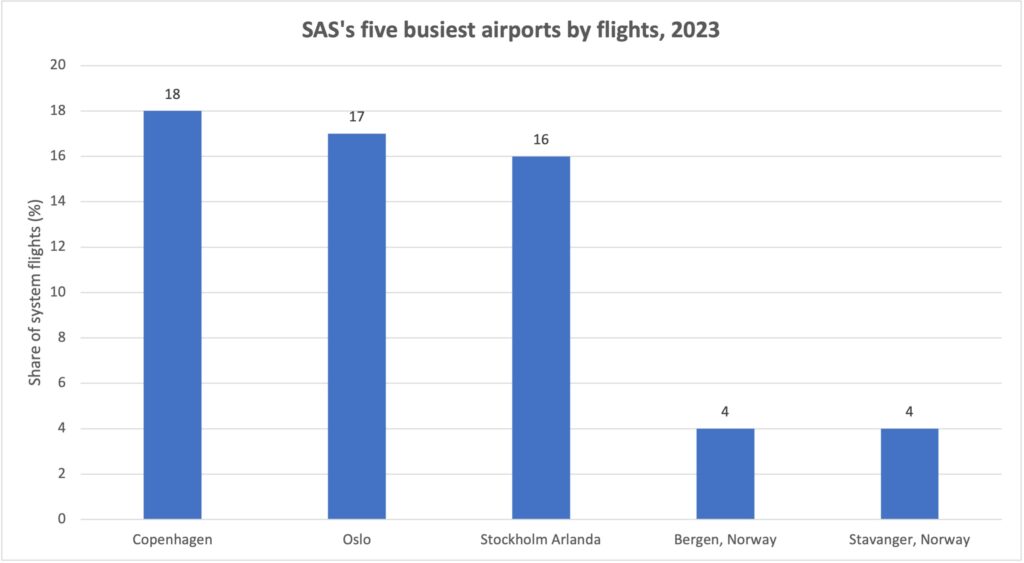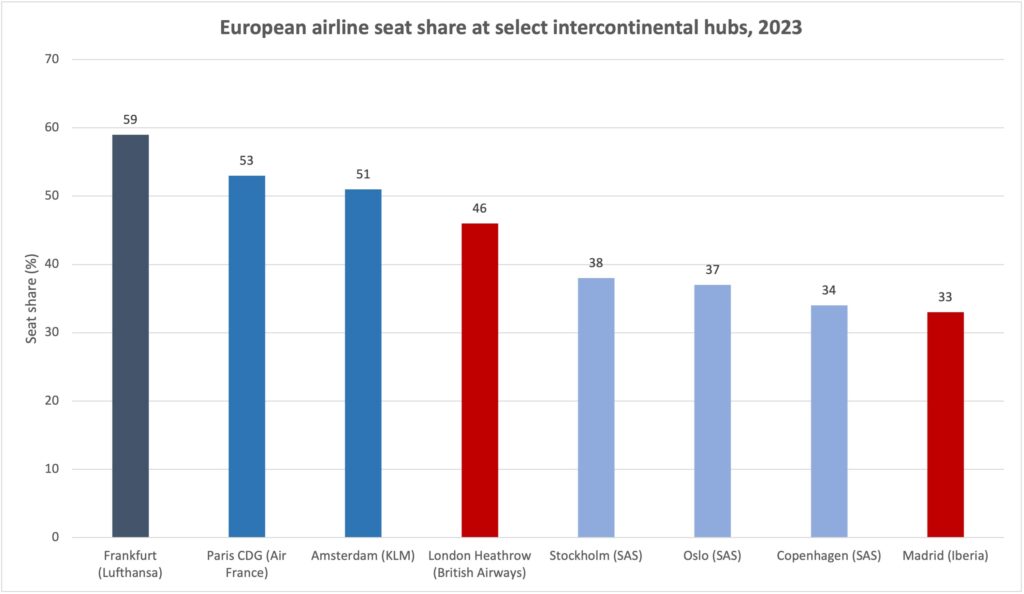Air France-KLM’s pending $145 million deal for a minority stake in Scandinavia’s SAS is the latest move among Europe’s consolidating airlines. But there are more questions than answers as the industry waits to see if the deal will come to fruition as part of the Scandinavian carrier’s bankruptcy restructuring.
We know that SAS will join the SkyTeam Alliance and leave Star Alliance, in which it was a founding member, once the deal is complete. Close is not expected until sometime next year. And, as Air France-KLM CEO Ben Smith told CNN, it intends to “integrate SAS into our JV” with Delta Air Lines and Virgin Atlantic.
What we don’t know includes just how much control of SAS Air France-KLM seeks; its initial investment is for only 19.9% but it has the option to take a majority stake after two years. The group’s plans for the carrier’s Stockholm headquarters, its EuroBonus loyalty program, and its network strategy are also unknowns. That last point was a hot topic at the Routes World conference in Istanbul this week, where airport officials and network planners met to discuss airline route strategy.
“For us, it’s good news that they have found a solution,” Swedavia Director of Aviation Business Elizabeth Axtelius said at the conference. She referred to the $1.18 billion equity investment in SAS planned by Air France-KLM, U.S. investment firm Castlelake, Danish firm Lind Invest, and the government of Denmark.
Swedavia operates the airports in Sweden, including Stockholm Arlanda, which is home to SAS’s third largest hub by both flights and seats, according to Cirium Diio schedules.
SAS’s largest hub by flights is in Copenhagen and its second largest Oslo. The airline was formed by the governments of Denmark, Norway, and Sweden in 1946.

But the future of the carrier’s three hubs — all of which are small when compared to the likes of Amsterdam or Frankfurt — is in question. Smith, in his interview with CNN, only added fuel to the fire.
“We view it as a stronger position within Europe,” he said of adding SAS’s routes to the Air France-KLM network. “To have a third global hub, or a fourth global hub, we think is important.”
Given SAS maintains three hubs and Air France-KLM has two hubs — Amsterdam Schiphol and Paris Charles de Gaulle — the implication was that one of SAS’s hubs is likely to go under full group ownership.
Closing hubs is often synonymous with airline consolidation, with airlines looking to streamline and eliminate redundancies. For example, in the U.S., United Airlines closed Continental Airlines’ Cleveland hub after the two merged in 2010; Delta closed Northwest Airlines’ Memphis hub after their merger in 2009; and America West Airlines management closed US Airways’ Pittsburgh hub after their combination in 2005.
Copenhagen Strength
“The most logical hub is for us the most southern point in our network, right?” SAS CEO Anko Van der Werff said earlier in October. “The direction of travel for most Scandinavians is immediately south because we live so far north. And the most southern point is Kastrup [Copenhagen]. So for sure, we will also focus very much on Kastrup.”
Just over 18% of SAS’s flights originate from Copenhagen this year, Cirium Diio schedules show. Oslo handled more than 16% of flights, and Stockholm right around 16%.
But SAS’s market position in Copenhagen — as in all of its hubs — is small when compared to other European airlines’ largest hubs. The airline will operate roughly 34% of the seats at Kastrup this year, according to Cirium Diio. That compares to nearly 51% for KLM in Amsterdam, and 59% for Lufthansa in Frankfurt.
A higher share of hub seats often — but not always — translates to greater market pricing strength for an airline.

“I believe there is some need for hub capacity” in Air France-KLM, said Morten Mortensen, senior director of airline sales and route development of Copenhagen Airports, at the Routes conference. Access to the Scandinavian market and the likely capacity cuts at Amsterdam Schiphol are the reasons he sees for the acquisition, Mortensen added.
The Dutch government is pushing to reduce the number of flight movements at Schiphol in order to reduce noise pollution in nearby neighborhoods. In September, it notified airlines that the number of aircraft movements — one equals either a takeoff or landing — at the airport would decrease by nearly 8% from pre-pandemic levels to 280,645 next summer. The summer season stretches from March to October.
KLM and other airlines have sued to stop the cuts at Schiphol from occurring but, for now, they stand.
Copenhagen, just under 400 miles to the northeast of Amsterdam, has room to grow. The airport has runway capacity for roughly 60 million annual passengers and terminal capacity for around 40 million, Mortensen said. Copenhagen handled 22 million passengers last year, and 30 million before the pandemic in 2019.
The Danish capital is also closer to East Asia than either Amsterdam or Paris, Mortensen noted. That is a strategic advantage as long as Russian airspace is closed to European airlines and flights must take circuitous and lengthier routes between Europe and East Asia.
The Stockholm Question
Stockholm is the hub whose future at SAS is most in question. Asked about the matter last month, Van der Werff dodged commenting specifically on the future of the hub — or SAS’s headquarters there — saying only that the airline had no intention to stop flying point-to-point routes from Stockholm, and also serving some domestic Sweden connecting traffic at the airport.
“We don’t know” what will happen, Axtelius said when asked about Swedavia’s view on the future of SAS’s Stockholm hub. She described the airline as a very “important customer” for the operator, and cited the fact that the airline is the largest at many of its airports across Sweden and not just in Stockholm.
The focus now for the airport is keeping Star member airlines in Stockholm when SAS leaves for SkyTeam, she said. Stockholm is served by 13 Star carriers, including its European members as well as foreign members including Ethiopian Airlines, Thai Airways, and United, Cirium Diio schedules show.
Axtelius did say that SAS’s decision to consolidate longhaul international flights in Copenhagen as part of its restructuring was a “disaster” for Swedavia at Arlanda. To the U.S., the airline cut service to Los Angeles, and retained only Miami and Newark, according to Cirium Diio.
SAS will have a 38% share of seats at Arlanda this year, Cirium Diio data show. It’s followed by Norwegian Air with an 18% share, and Ryanair with 11%. Discounters Eurowings and Wizz Air are also expanding at the airport.
Neutral Oslo
Oslo is the third hub for SAS, and the one which few are discussing its future at the airline. It is not an international gateway for the airline but is the airline’s largest by seats. That is mostly driven by the country’s domestic market — and strong corporate sector that SAS dominates — as well as demand for flights within Europe.
We “think this is more a neutral for us,” Avinor Vice President of Traffic Development Gaute Riise said of the Air France-KLM deal at Routes. Avinor operates the Oslo airport and others in Norway.
He acknowledged that the Copenhagen Airport, given its location, was the most likely to benefit from Air France-KLM’s investment in SAS. Riise did not comment on the future of the airline’s Stockholm hub.
SAS is the second largest airline in Oslo with a 37% share of seats this year, according to Cirium Diio. Norwegian Air is the largest with a nearly 42% share, and that share stands to grow by nearly two points if its acquisition of regional airline Wideroe is approved.
“Oslo will be important,” Riise said. “It’s a huge domestic market for SAS.”
Van der Werff himself echoed that view of SAS’s Oslo hub in August when asked about competition from Norwegian Air there.
“I don’t think that there is any diminishing from us” in Norway, he said citing the airline’s domestic network and airport slot portfolio.





